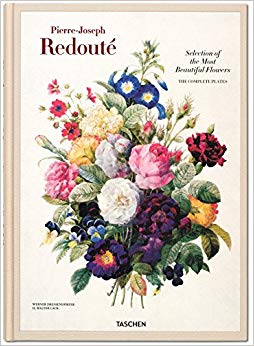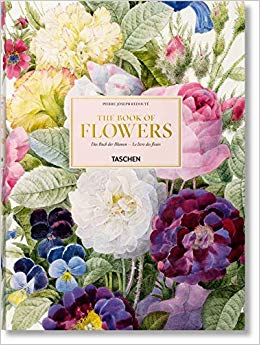Background
Pierre-Joseph Redouté was born on July 10, 1759, in Saint-Hubert, Belgium. Redoute was the son of a modest interior decorator and painter of church pieces, Charles-Joseph Redoute.

1812
Metrosyderos glauca (1812). Drawing (watercolour and bodycolour over graphite on vellum, margins ruled in red and gold ink) The Fitzwilliam Museum
1825
On January 14, 1825, King Charles X honored Pierre-Joseph as a Chevalier de la Légion d'honneur.
1831
A Flowering Cactus: Heliocereus Speciosus, watercolour on vellum, Framed- 27 5/8 x 22 1/2 x 3 1/4 in. (70.17 x 57.15 x 8.26 cm), Los Angeles County Museum of Art.
1834
Redoute was awarded the Ordre de Leopold of Belgium.
Portrait of Pierre-Joseph Redouté by Louis Léopold Boilly.
Pierre-Joseph Redouté, engraving.
botanical illustration by Pierre-Joseph Redouté
botanical illustration by Pierre-Joseph Redouté
botanical illustration by Pierre-Joseph Redouté
botanical illustration by Pierre-Joseph Redouté
botanical illustration by Pierre-Joseph Redouté
botanical illustration by Pierre-Joseph Redouté
botanical illustration by Pierre-Joseph Redouté
botanical illustration by Pierre-Joseph Redouté
botanical illustration by Pierre-Joseph Redouté
botanical illustration by Pierre-Joseph Redouté
botanical illustration by Pierre-Joseph Redouté
Crown Imperial. Fritillaria imperialis var. jaune par P.J. Redouté. Plate of watercolor . Choix des plus belles fleurs et des plus beaux fruits, t. 2, P.J. Plate is 1827.
Père Lachaise Cemetery, Paris, France
Tomb of Pierre-Joseph Redouté (1759-1840) at Père Lachaise Cemetery in Paris.
Rosa Gallica Versicolor; Rosier de France a fleurs panachees by PJ Redoute - from 'Les Roses' (1817) - The Miriam and Ira D. Wallach Division of Art, Prints and Photographs: Print Collection, The New York Public Library.
Rosa Damascena Variegata; Rosier d'Yorck et de Lancastre by PJ Redoute - from 'Les Roses' (1817) - From: The Miriam and Ira D. Wallach Division of Art, Prints and Photographs: Print Collection, The New York Public Library.










(Pierre-Joseph Redouté was an official court draftsman to ...)
Pierre-Joseph Redouté was an official court draftsman to Queen Marie Antoinette (who purportedly summoned him at midnight to paint a cactus), and later a favorite of Joséphine Bonaparte, the artist brought flowers to the highest of places, and offset the chaotic upheaval of the French Revolution with the delicacy of perfectly drawn petals. This reprint brings together 144 examples of Redouté’s flower, branch, and fruit drawings.
https://www.amazon.com/Redout%C3%A9-Selection-Most-Beautiful-Flowers/dp/3836505150/?tag=2022091-20
2018

(This elegant catalogue brings together all engravings fro...)
This elegant catalogue brings together all engravings from Redouté’s illustrations of Roses and Choix des plus belles fleurs (Selection of the Most Beautiful Flowers) and the most astounding images from The Lilies. Offering a vibrant overview of Redouté’s admixture of accuracy and beauty, it is also a privileged glimpse into the magnificent gardens and greenhouses of a bygone Paris.
https://www.amazon.com/Redoute-Book-Flowers-XL-Multilingual/dp/3836568934/?tag=2022091-20
2019
artist Botanist engraver illustrator scientist
Pierre-Joseph Redouté was born on July 10, 1759, in Saint-Hubert, Belgium. Redoute was the son of a modest interior decorator and painter of church pieces, Charles-Joseph Redoute.
In 1782 Redouté moved to Paris to find scope for his artistic talent. While sketching flowers for pleasure in the Jardin du Roi, Redoute was discovered by the botanist C. L. L’Heritier de Brutelle, who trained him as a botanical artist and employed him to illustrate his publications. Through L'Heritier, Redoute’s artistic development came under the guidance of Gerardus van Spaendonck (1746-1822), a professor of flower painting at the Jardin du Roi.
At the age of thirteen, having learned what he could at home, Redouté set out with his paintbox to explore Flanders and the Low Countries. During the next decade he earned an uncertain living as an itinerant artist (in the same tradition as that of the 'limners' who were roaming the American colonies), studied the available old masters, managed to acquire a year of further training in an atelier at Liege, and underwent something like a conversion, in Amsterdam, by discovering the work of the finest of the Dutch eighteenth-century flower painters, Jan van Huysum.
His first interest was in botanical illustration. He began to frequent the Jardin des Plantes (then still the Jardin du Roi but already, under the energetic Buffon's direction, a splendid scientific enterprise), where he met a wealthy Linnaeus disciple, Charles Louis L'Heritier de Brutelle, and profited from the encouragement of Gerard van Spaendonck, a Dutch water-colorist who had become the institution's professor of flower painting. L'Heritier took the obviously gifted young provincial under his wing, gave him access to a large botanical library, and involved him in a trip to England to study the exotic plants at Kew.
By 1788 Redouté was the illustrator of two of his patron's books, Stirpes Novae and Sertum Angicum; a year later he was named, probably at L' Heritier's suggestion, draughtsman to the cabinet of Marie-Antoinette.
During the Terror of the French Revolution, he was appointed to the staff of the former royal botanical garden, which had become the Jardin des Plantes and the Museum National d’Histoire Naturelle, with the Rousseauist Bernardin de Saint-Pierre as director. By now he was showing his pictures of flowers, fruit, and mushrooms in the official Salon and serving on the powerful jury of well-known painters (including David, Vien, Gerard, Fragonard, and Carl Vernet) that dispensed awards to exhibitors.
Under the Directory, which brought a burst of spending by nouveaux riches tired of Revolutionary austerity, he continued to prosper and began to gravitate towards the rising star of Bonaparte.
Between 1798 and 1804 appeared, or began to appear, since some of the productions came out in installments over several years, his illustrations for his Les Liliacées, for A. P. de Candolle’s Plantes Grasses (partly undertaken earlier), for André Michaux’s Histoire des Chênes & Mmérique, for the same author’s Flora Boreali-.dmericana, for Duhamel du Monceau’s Traité des fibres et .drbustes and for Etienne-Pierre Ventenat’s Jardin de la Mamaison - ultimately a grand total of more than a thousand plates.
By the time of the 1805 edition of Rousseau’s Botanique Pierre-Joseph Redouté was a celebrity,’ le Raphael desfieurc, and a well-to-do businessman with a fashionable clientele, a private apartment in the Louvre, a country residence near Paris at Fleury-sous-Meudon (where Jean-Jacques had once botanized), and a salary of 18,000 francs a year as Josephine’s decorator and flower painter at Malmaison.

Redoute's greatest achievement was in the development for botany the technique of color printing by means of stipple engravings a la poupee, with which he produced some of the finest colored botanical illustrations ever published. The combination of scientific botanical precision and innate artistry made Redoute one of the greatest flower painters. Many of the paintings from his Roses are still reproduced on a large scale. The scientific value of his paintings and books lies especially in the documentation of the original specimens of plants new to science and described in his time. Overall, he produced over 2,100 paintings for published plates depicting over 1,800 different species, many of which had never been rendered before.
The darling of wealthy Parisian patrons including Napoleon’s wife Josephine, he was dubbed “the Raphael of flowers,” and is regarded to this day as a master of botanical illustration. For his greatest work, Pierre-Joseph Redouté was awarded the Legion of Honour and became a Chevalier of the Legion of Honour. In 1834 he was awarded the Ordre de Leopold of Belgium.
A Brussels school bears his name: the Institut Redouté-Peiffer in Anderlecht. In the 20th and 21st centuries, numerous exhibitions in Europe, the Americas, and Australia have been devoted to the work of Redouté.
(Pierre-Joseph Redouté was an official court draftsman to ...)
2018(This elegant catalogue brings together all engravings fro...)
2019Redoute devoted himself exclusively to capturing the diversity of flowering plants in watercolor paintings which were then published as copper engravings, with careful botanical descriptions.
A contemporary of Redouté, the memoir-writer Joseph-Francois Grille, describes him: "A dumpy body, limbs like an elephant’s, his head as heavy and flat as a Dutch cheese, thick lips, a hollow voice, crooked fingers, a repulsive look, and beneath the skin an extremely delicate sense of tact, exquisite taste, a deep feeling for art, a fine sensibility, nobility of character, and the perseverance needed for the development of genius: such was Redouté, who had all the pretty women in Paris as his pupils."
Pierre-Joseph Redouté was survived by his wife, Marie-Marte Gobert, whom he married in 1786, and their two daughters.
The eldest of the Redouté brothers, Antoine-Ferdinand, had become a stage-set designer in Paris.
The youngest of the Redouté brothers, Henri-Joseph, served under the general in Egypt as a zoological draughtsman.
15 June 1746 – 18 August 1800, an 18th-century French botanist and magistrate.


Maria Antonia Josepha Johanna; 2 November 1755 – 16 October 1793) was the last Queen of France before the French Revolution. She was born an Archduchess of Austria and was the penultimate child and youngest daughter of Empress Maria Theresa and Francis I, Holy Roman Emperor.

23 June 1763 – 29 May 1814, the first wife of Napoleon and the first Empress of the French after he proclaimed himself Emperor. She became Redouté's patron and appointed him to paint the flowers of the garden at Malmaison.
